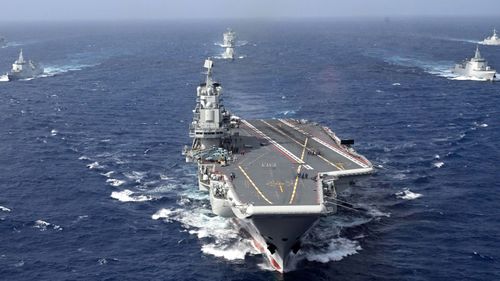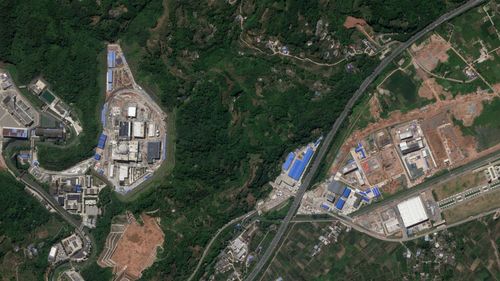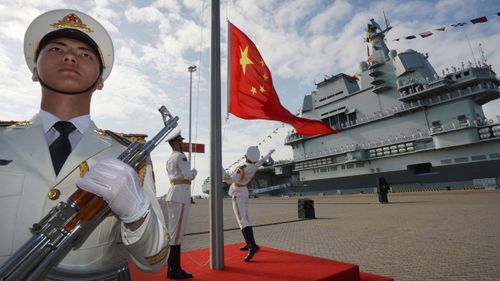The Chinese navy is already numerically the largest in the world and is being rapidly modernized.
Adding a nuclear-powered carrier to its fleet would be a major step in realizing its ambitions for a true “blue water” power capable of operating in seas far from China in a growing global challenge to the United States.

“Nuclear-powered carriers would place China in the exclusive ranks of first-class naval powers, a group currently limited to the United States and France,” said Tong Zhao, a senior fellow at the Carnegie Endowment for International Peace in Washington, DC.
“For China’s leadership, such a development would symbolize national prestige, fueling domestic nationalism and raising the country’s global image as a leading power.”
Researchers at the Middlebury Institute of International Studies in California said they made the discovery while investigating a mountain site outside the city of Leshan in southwest China’s Sichuan province, where they suspected China was building a reactor to produce weapons-grade plutonium or tritium.
Instead, they concluded that China was building a prototype reactor for a large warship.
The Leshan project is called the Longwei, or Dragon Might, Project, and is also referred to in the documents as the Nuclear Energy Development Project.
Neither China’s Ministry of Defense nor Ministry of Foreign Affairs responded to requests for comment.
Satellite images and public documents helped identify the likely owner of the project
China has long been rumored to be planning to build a nuclear-powered aircraft carrier, but research by a Middlebury team is the first to confirm that China is working on a nuclear propulsion system for a carrier-sized surface warship.
“The Leshan reactor prototype is the first hard evidence that China is, in fact, developing a nuclear-powered aircraft carrier,” said Jeffrey Lewis, a professor at Middlebury and one of the researchers on the project.
“Operating a nuclear-powered aircraft carrier is an exclusive club that China looks set to join.”
Drawing on satellite imagery and public documents including project tenders, personnel files, environmental impact studies — and even citizen complaints about noisy construction and excessive dust — they concluded that a prototype marine-powered reactor is being built in the mountains of Mucheng Municipality, about 112 kilometers southwest of the capital of Sichuan province Chengdu.

The reactor, which procurement documents show will soon be operational, is housed in a new facility built on a site known as Base 909, which houses six other reactors that are operational, decommissioned or under construction, according to the analysis.
The site is under the control of the China Nuclear Energy Institute, a subsidiary of the China National Nuclear Corporation, which is in charge of reactor engineering research and testing.
Documents show that China’s 701 Institute, officially known as the China Ship Research and Design Center, which is responsible for aircraft carrier development, has acquired reactor equipment “intended for installation on a large surface warship” under the Nuclear Power Development Project, as well as of the project “mark for national defense” led to the conclusion that the massive reactor is a prototype for the next generation aircraft carrier.
Satellite mags from 2020 to 2023 showed the demolition of homes and construction of water intake infrastructure associated with the reactor site.
The contracts for the steam generators and turbine pumps indicate that the project includes a pressurized water reactor with a secondary circuit — a profile consistent with naval propulsion reactors, the researchers said.
The environmental impact report calls the Longwei project a “national defense-related construction project” that is classified as “secret.”

“Unless China is developing nuclear-powered cruisers, pursued only by the United States and the Soviet Union during the Cold War, then the Nuclear Power Development Project most certainly refers to efforts to develop nuclear-powered aircraft carriers,” the researchers wrote in a detailed report. in 19 pages about their findings, which they shared exclusively with the AP.
Jamie Withorne, an analyst at the Oslo Nuclear Project who was not involved in the research and reviewed the findings, said the Middlebury team made a “compelling argument.”
“From the identification report, the co-location with other naval reactor facilities, and the related construction activities, I think it can be said that the Longwei project is probably located at the 909 base, and could potentially be located in the identified building,” she said.
However, the research gives no indication of when China’s nuclear-powered carrier might be built and become operational, she said.
Sarah Laderman, a senior analyst at the Open Nuclear Network, a program of the US-based PAX sapiens foundation, said the findings were “carefully conducted and thoroughly researched”.
“Given the evidence presented here, I see a compelling case that China appears to be working on building a nuclear propulsion system for its naval surface ships (probably aircraft carriers) at this location,” said Laderman, who is based in Vienna and was not involved in Middlebury Research.
The search for a nuclear-powered carrier
The first Chinese carrier, commissioned in 2012, was a repurposed Soviet ship, and the second was built in China but based on a Soviet design.
Both ships — named Liaoning and Shandong — use a so-called “ski-jump” launch method, with a ramp at the end of a short runway to help the planes take off.
Type 003 Fujian, launched in 2022, was the country’s third carrier and the first to be designed and built domestically.
It uses an electromagnetic type launch system like those developed and used by the US Navy. All three carriers have a conventional drive.
Naval trials had not even begun for Fujian in March when Yuan Huazhi, the Political Commissar of the Chinese People’s Liberation Army Navy, confirmed the construction of a fourth carrier.
Asked if it would be nuclear-powered, he said at the time that it would “be announced soon,” but not yet.
There has been speculation that China might start building two new carriers at once – one Type 003 like the Fujian and one nuclear-powered Type 004 – something it has not attempted before, but its shipyards have the capacity to do so.
Matthew Funaiole, a senior fellow at the China Power Project at the Center for Strategic and International Studies, said he doubts China’s next carrier will be nuclear-powered.
Instead, he said, he expects the People’s Liberation Army’s fourth carrier to focus on optimizing the existing Fujian carrier design with “incremental improvements.”
Nick Childs, senior fellow for naval forces and maritime security at the International Institute for Strategic Studies, said the Chinese “have taken an incremental approach to developing their aircraft carriers with a range of ambitions that will evolve over time”.
Ultimately, however, “larger carriers more akin to their American counterparts will give them more opportunities to project power,” Childs said.
It will take several years to build the carrier and put it into service, but developing nuclear power for the next generation of warships would give China more power to launch advanced systems, such as electromagnetic launchers, radars and new technological weapons, Childs said.
“As well as removing the ship’s need for regular refueling and therefore giving it a much longer range, nuclear power means that without the need to carry fuel oil for the ship, there will be room for fuel and weapons for its aircraft, expanding their capabilities,” Childs said.
“Much will depend on the overall size of the next carrier, but the addition of nuclear power will represent a significant step forward in developing a Chinese carrier with a ship comparable to that of the US Navy.”
Zhao, of the Carnegie Endowment for International Peace, said nuclear-powered carriers would give China’s military “greater flexibility and endurance to operate around strategic hotspots, especially along the First Island Chain, where most of the territory disputed by China is located.” Zhao.
The first island chain includes the self-governing island of Taiwan, which China claims as its own and vows to annex by force if necessary.
The US is bound by domestic law to supply Taiwan with enough weapons to deter an invasion, and could provide aid to the island from its bases in the Pacific in the event of an invasion or blockade.
Tensions have also risen in the South China Sea between China and neighboring states over territorial disputes and maritime claims.
“These carriers could also extend China’s operations deeper into the western Pacific, further challenging the US military’s ability to ‘intervene’ in regional issues that China feels are best handled only by countries in the region,” Zhao said.

A girl’s miraculous survival unravels a murder on a sailboat
Chinese President Xi Jinping has tasked defense officials with building a “first-class” navy and becoming a maritime power as part of his plan to rejuvenate the country.
The country’s latest national defense white paper in 2019 said China’s navy is adapting to strategic demands by “accelerating the transition of its tasks from near-sea defense to far-sea protection missions.”
The Navy of the People’s Liberation Army is already the world’s largest navy with more than 370 ships and submarines.
The country also boasts powerful shipbuilding capabilities: Chinese shipyards build hundreds of ships each year, while the U.S. builds five or fewer, according to a report to the U.S. Congress late last year.
However, the Chinese navy lags behind the US in many ways.
Among other advantages, the US currently has 11 carriers, all nuclear-powered, allowing it to keep multiple strike groups deployed around the world at all times, including in the Indo-Pacific.
But the Pentagon is increasingly concerned about China’s rapid modernization of its fleet, including the design and construction of new carriers.
This is in line with China’s “increasing emphasis on maritime assets and increasing requirements” for its navy “to operate at greater distances from mainland China,” the Defense Department said in its latest report to Congress on China’s military.
And China’s “growing aircraft carrier strength extends the air defense coverage of deployed task forces beyond the range of land defenses, enabling operations further off China’s coast,” the report said.
